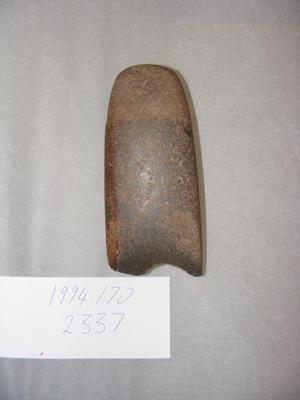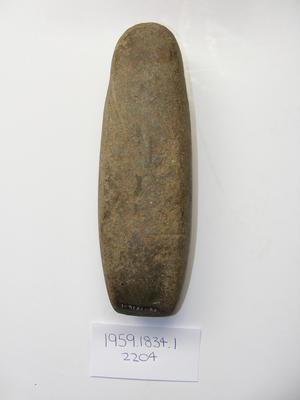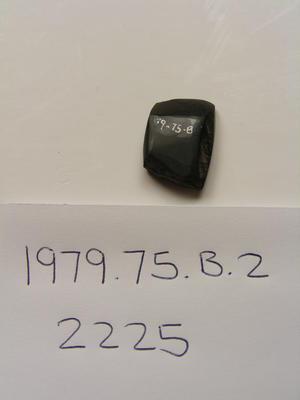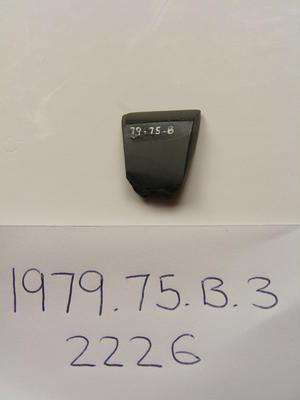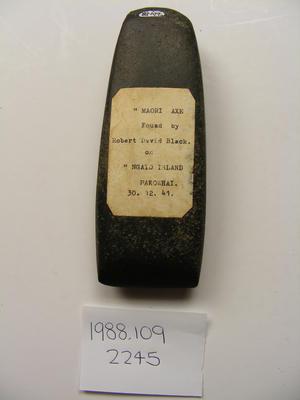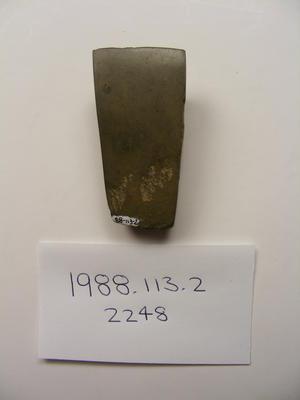Te Aitanga-a-Māhaki
Biography
Te Aitanga a Mahaki trace their beginnings from the waiata "Haramai a Paoa". The maunga in shape the haumi, and the land where Paoa found the totara to repair Horouta. The quotation is immortalised in the land, "Te manga i tu ai te rakau a Paoa", Mangatu.
Ko Maungahaumi te maunga
Ko Mangatu te whenua
Ko Waipaoa te awa
Ko Te Aitanga a Mahaki te iwi
Haramai a Paoa i runga i tona waka i a Horouta
Ka pakaru ki Tuaranui o Kanawa
Ka haramai ki uta ki te rapa haumi, ki te rapa punaki
Ka kitea te haumi, ka kitea te punaki
E kai kamakama, ka miia tona mimi
Rere ana Motu, rere ana Waipaoa
Ko Kopututea te putanga ki waho
Ki a unu mai tona kuri, e pakia mai nei
E nga ngaru o te moana, e takoto nei
Ka huri ka huri te haere a Paoa
Ki te Tairawhiti e!
The Horouta waka arrived at Ohiwa in the Bay or Plenty. In an attempt to cross a sandbar named Tukerae o Kanawa, the haumi of the Horouta snapped in half. To make repairs to the waka, Paoa took a party of warriors inland to search for a suitable tree. On a large mountain they found what they sought, and named the mountain Maungahaumi, where Paoa needed to relieve himself forming Te Mimi a Paoa, (the Waipaoa River), flowing south, and the Motu River, flowing north of the mountain.
The repaired waka headed east, rounding the East Cape following the coastline south, greeting the descendants of Toi, replenishing water and food as they went. Some of the Horouta descendants remained and settled with the Toi descendants on the way, whilst the rest continued south until they reached a large bay where Kiwa set up a rahui tuahu claiming the area in the names of the remaining crew of Horouta. The landing place was named Turanganui A Kiwa. To celebrate their discovery, Hineakua the daughter of Paoa, was given in marriage to Kahutuanui, the son of Kiwa, producing the future descendants of Turanganui A Kiwa.
The marriage of Rakaikoko, a descendant of Hine Hakirirangi, sister of Paoa, into the Kiwa - Paoa family, was an important alliance. Hine Hakirirangi was the ancestor who, it is said,to have nurtured and brought the kumara from Hawaikii in her sacred kete, and planted the vines at Manawaru and Araiteuru, as sustenance for the tribe.
When Kahukuranui reached manhood he decided to come to Turanganui a Kiwa to visit his older brother, Ruaroa, and after a time married Ruatapuwahine, daughter of Ruapani (chart II). From this union was born Rakaihikuroa, who married two sisters, Hineteraraku and Te Orapa, grandchildren of Ruaroa. Rakaihikuroa established his marae at Pukepoto on the Repongaere Block where he lived with his sons.
The battle between Rakaihikuroa and Kahutapere was asaid to be the first battle to establish the iwi called Te Aitanga a Mahaki. Before the separation, this area was known as Ngati Ruapani or Ngati Kahungunu.
The return of Kahukuranui was followed by his nephews, Tawhiwhi and Mahaki. After a period of time other whanau groups were established; Kahutapere at Korowhiorau, Tutekohi at Whenuanui, Taururangi at Kauaenui and Mahaki and his whanau were established at Pawerawera.
Rakaihikuroa, because of his rangatira line to Ruapani felt that his son, Tupurupuru, should be the rangatira of Turanganui a Kiwa. "kia kotahi ra te whetu ki te rangi, ko Tupurupuru." Meanwhile, the people were paying tribute to the twins of Kahutapere, Tarakiuta and Tarakitai, creating a problem for Rakaihikuroa, who took the direct approach of killing the twins.
When Kahutapere discovered that Rakaihikuroa was too strong for him, he called on Mahaki, his whanau and his neighbours, Taururangi and Kahutauranga. Whakarau, who was away hunting at the time, later joined the battle at Pukepoto where he faced and killed Tupurupuru. While Tupurupuru lay wounded his brothers wanted to finish him off. Whakarau said, "kia watea, kia watea, waiho i kona te ika o te aho a te potiki a Hinetapuarau kia kahakihaki." From this incident is the name Ngapotiki, one of the main hapu groups of Te Aitanga a Mahaki, who claim Whakarau as their tipuna.
When Rakaihikuroa realised the fate of his son, he arranged that Mahaki should have his greenstone adze to cook the body of Tupurupuru. The names of the adze are: Te Whatupura, Te Whatumoana, Te Whatu o Ngahua, Te Whatu o Poutini, Te Whatutangiura. Because of this gift it is believed that Tupurupuru was cooked and eaten, however, elders of Te Aitanga a Mahaki have taught us that the body of Tupurupuru was taken and hidden on the Tangihanga Block where it remains to this day,
This battle resulted in the departure from Turanga of Rakaihikuroa, his sons, Taraia, Tamanuhiri, Tuwhakawhiurangi and a section of the whanau of Ruapani, of his second wife, Uenukukoihu. This battle is said to be the first battle in the establishment of Te Aitanga a Mahaki. Rakaihikuroa moved to Te Wairarapa, married into tangata whenua and became Ngati Kahungunu ki te Wairarapa. Rangitawhio moved inland to his mothers people, settled at Rangatira and became known as Ngati Rangitawhio. Rakaipaaka moved to Mahia and Nuhaka and became known as Ngati Rakaipaaka. Hinemanuhiri married Te Pukaru, son of Ruapani and became known as Ngatihine of Ngati Kahungunu ki Te Wairoa. Kahutapere moved to Hangaroa and finally settled in Whakatane.
Hapu groups of Te Aitanga a Mahaki:
Ngapotiki take their name from Whakarau, marae are Tapuihikitia and Takitimu.
Whanau a Iwi take their name from Tauwheoro with Tarere as their marae.
Ngai Tamatea take their name from Tamateaiti with Taihamiti as their marae.
Ngati Wahia take their name from Wahia with their marae as Mangatu and Parihimanihi.
Ngai Tawhiri take their name from Whakauaki with their marae as Te Kuri and Tarere.
Ngai Tuketenui is not an active hapu and do not have a current marae.
Te Whanau a Kai take their name from Kaikoreaunei with their marae as Rongopai and Pakowhai.
Te Whanau a Taupara take their name from Taupara with their marae as Tapuihikitia and Takipu.
There are various groups of Ngariki who all have an association with Te Aitanga a Mahaki.
(accessed 13/11/2018 from: https://www.mahaki.com/our-history.html)
Ko Maungahaumi te maunga
Ko Mangatu te whenua
Ko Waipaoa te awa
Ko Te Aitanga a Mahaki te iwi
Haramai a Paoa i runga i tona waka i a Horouta
Ka pakaru ki Tuaranui o Kanawa
Ka haramai ki uta ki te rapa haumi, ki te rapa punaki
Ka kitea te haumi, ka kitea te punaki
E kai kamakama, ka miia tona mimi
Rere ana Motu, rere ana Waipaoa
Ko Kopututea te putanga ki waho
Ki a unu mai tona kuri, e pakia mai nei
E nga ngaru o te moana, e takoto nei
Ka huri ka huri te haere a Paoa
Ki te Tairawhiti e!
The Horouta waka arrived at Ohiwa in the Bay or Plenty. In an attempt to cross a sandbar named Tukerae o Kanawa, the haumi of the Horouta snapped in half. To make repairs to the waka, Paoa took a party of warriors inland to search for a suitable tree. On a large mountain they found what they sought, and named the mountain Maungahaumi, where Paoa needed to relieve himself forming Te Mimi a Paoa, (the Waipaoa River), flowing south, and the Motu River, flowing north of the mountain.
The repaired waka headed east, rounding the East Cape following the coastline south, greeting the descendants of Toi, replenishing water and food as they went. Some of the Horouta descendants remained and settled with the Toi descendants on the way, whilst the rest continued south until they reached a large bay where Kiwa set up a rahui tuahu claiming the area in the names of the remaining crew of Horouta. The landing place was named Turanganui A Kiwa. To celebrate their discovery, Hineakua the daughter of Paoa, was given in marriage to Kahutuanui, the son of Kiwa, producing the future descendants of Turanganui A Kiwa.
The marriage of Rakaikoko, a descendant of Hine Hakirirangi, sister of Paoa, into the Kiwa - Paoa family, was an important alliance. Hine Hakirirangi was the ancestor who, it is said,to have nurtured and brought the kumara from Hawaikii in her sacred kete, and planted the vines at Manawaru and Araiteuru, as sustenance for the tribe.
When Kahukuranui reached manhood he decided to come to Turanganui a Kiwa to visit his older brother, Ruaroa, and after a time married Ruatapuwahine, daughter of Ruapani (chart II). From this union was born Rakaihikuroa, who married two sisters, Hineteraraku and Te Orapa, grandchildren of Ruaroa. Rakaihikuroa established his marae at Pukepoto on the Repongaere Block where he lived with his sons.
The battle between Rakaihikuroa and Kahutapere was asaid to be the first battle to establish the iwi called Te Aitanga a Mahaki. Before the separation, this area was known as Ngati Ruapani or Ngati Kahungunu.
The return of Kahukuranui was followed by his nephews, Tawhiwhi and Mahaki. After a period of time other whanau groups were established; Kahutapere at Korowhiorau, Tutekohi at Whenuanui, Taururangi at Kauaenui and Mahaki and his whanau were established at Pawerawera.
Rakaihikuroa, because of his rangatira line to Ruapani felt that his son, Tupurupuru, should be the rangatira of Turanganui a Kiwa. "kia kotahi ra te whetu ki te rangi, ko Tupurupuru." Meanwhile, the people were paying tribute to the twins of Kahutapere, Tarakiuta and Tarakitai, creating a problem for Rakaihikuroa, who took the direct approach of killing the twins.
When Kahutapere discovered that Rakaihikuroa was too strong for him, he called on Mahaki, his whanau and his neighbours, Taururangi and Kahutauranga. Whakarau, who was away hunting at the time, later joined the battle at Pukepoto where he faced and killed Tupurupuru. While Tupurupuru lay wounded his brothers wanted to finish him off. Whakarau said, "kia watea, kia watea, waiho i kona te ika o te aho a te potiki a Hinetapuarau kia kahakihaki." From this incident is the name Ngapotiki, one of the main hapu groups of Te Aitanga a Mahaki, who claim Whakarau as their tipuna.
When Rakaihikuroa realised the fate of his son, he arranged that Mahaki should have his greenstone adze to cook the body of Tupurupuru. The names of the adze are: Te Whatupura, Te Whatumoana, Te Whatu o Ngahua, Te Whatu o Poutini, Te Whatutangiura. Because of this gift it is believed that Tupurupuru was cooked and eaten, however, elders of Te Aitanga a Mahaki have taught us that the body of Tupurupuru was taken and hidden on the Tangihanga Block where it remains to this day,
This battle resulted in the departure from Turanga of Rakaihikuroa, his sons, Taraia, Tamanuhiri, Tuwhakawhiurangi and a section of the whanau of Ruapani, of his second wife, Uenukukoihu. This battle is said to be the first battle in the establishment of Te Aitanga a Mahaki. Rakaihikuroa moved to Te Wairarapa, married into tangata whenua and became Ngati Kahungunu ki te Wairarapa. Rangitawhio moved inland to his mothers people, settled at Rangatira and became known as Ngati Rangitawhio. Rakaipaaka moved to Mahia and Nuhaka and became known as Ngati Rakaipaaka. Hinemanuhiri married Te Pukaru, son of Ruapani and became known as Ngatihine of Ngati Kahungunu ki Te Wairoa. Kahutapere moved to Hangaroa and finally settled in Whakatane.
Hapu groups of Te Aitanga a Mahaki:
Ngapotiki take their name from Whakarau, marae are Tapuihikitia and Takitimu.
Whanau a Iwi take their name from Tauwheoro with Tarere as their marae.
Ngai Tamatea take their name from Tamateaiti with Taihamiti as their marae.
Ngati Wahia take their name from Wahia with their marae as Mangatu and Parihimanihi.
Ngai Tawhiri take their name from Whakauaki with their marae as Te Kuri and Tarere.
Ngai Tuketenui is not an active hapu and do not have a current marae.
Te Whanau a Kai take their name from Kaikoreaunei with their marae as Rongopai and Pakowhai.
Te Whanau a Taupara take their name from Taupara with their marae as Tapuihikitia and Takipu.
There are various groups of Ngariki who all have an association with Te Aitanga a Mahaki.
(accessed 13/11/2018 from: https://www.mahaki.com/our-history.html)

